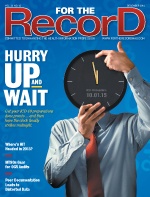December  2014
2014
Birth Data at Risk
By Dawn M. Lafferty, PhD
For The Record
Vol. 26 No. 12 P. 8
The United States Standard Certificate of Live Birth is the primary data source for monitoring and assessing the health outcomes of mothers and infants. Over the past few years, the conversion from paper records to EMRs has increased the accuracy of birth certificate records. However, hospital-based birth coders (abstraction professionals), who are typically responsible for the completion of birth certificates, face abstracting challenges when data are entered via cut-and-paste methods or pull-through technology.
In the Finger Lakes region of New York, birth coders, a local colloquialism for birth certificate registrars who technically have no affiliation with medical billing coders, work under the auspices of the Strong Memorial Hospital Regional Perinatal Center. With guidance from a quality assurance professional, a regional data coordinator, neonatologists, and experts in maternal fetal medicine, birth coders abstract the information contained within the mother's and infant's medical charts to complete the required fields to issue a birth certificate.
Finger Lakes birth coders are responsible for the correct abstraction of 40 sections in the state's birth certificate, a process that involves more than 350 data points. Converting to electronic records has helped enormously with this time-consuming task. Thanks to HIT, a job that used to take hours now is reduced to 50 minutes or less per chart. However, there is growing concern that some professionals, including medical assistants, nurses, and physician assistants, involved in the prenatal process are making liberal use of cloning technology to create a quick record of patient visits in order to avoid having recordkeeping consume much of their day.
Birth Data's Path
Collecting and transferring data from medical records to the birth certificate involves many people. Hospitals employ birth coders to abstract data and gather additional information directly from new mothers to complete the infant's birth record.
Once completed, birth data are transmitted to the state repository and eventually transferred to the National Center for Health Statistics, which compiles the information into a detailed database. In this setup, the health care professional who originates the prenatal record carries the largest influence in terms of data quality and presenting a complete health picture.
While birth data collection is subject to many error types, EHR functionality plays a leading role in the accuracy of its content. The technologies that make it convenient for health care professionals to copy and paste documentation from one record to another or pull information forward from a previous visit or another source can create inconsistencies in the birth record. For example, a hospitalist can cut and paste portions of a note from the previous day's rounds into the current day's account. Also, attending physicians may "pull forward" an obstetrician's note into their documentation and sign the document as if the information is from their own observations. In addition, health care organizations can develop templates in their EMR system that can autopopulate fields in a single click, resulting in extensive documentation that may contain incorrect information if it's not carefully reviewed.
These concerns echo those of the Office of Inspector General (OIG), which warns that the tools within an EMR system may allow a user to clone data entries or autogenerate extensive documentation entries. Not only would this create data abstraction challenges for birth certificate coders, but it also may pose a risk of patient identity mix-up or insurance fraud.
In December 2013, the OIG published a report that addressed the potential for fraud in EMR technology. The OIG surveyed 864 hospitals receiving incentive payments under the Medicare meaningful use program, conducted eight onsite hospital reviews, and interviewed prominent EHR vendors. Although the report did not condemn all uses of pull forward or copy-and-paste technologies, the OIG stated that "the copy-paste feature in EHRs can enhance efficiency of data entry," but doing so "may also facilitate attempts to inflate, duplicate, or create fraudulent health care claims."
The report also expressed concern over "check-the-box" documentation templates, which may be inaccurate if they are not appropriately edited. The OIG noted that check-the-box functions "can produce information suggesting the practitioner performed more comprehensive services than were actually rendered." This was not the first time the OIG expressed concern over EHR documentation practices. In both its annual work and strategic plans, the agency listed ensuring the accuracy of documentation as a priority.
Guidelines Needed
The birth coders of the Finger Lakes region value the use of EMR technology and find it useful in their daily tasks. The concern is that since the validity of the birth certificate data depends on accurate data abstraction, the unfettered use of cloning technology may compromise the data. This will have the unintended effect of tainting the nation's primary data source for monitoring and evaluating the health outcomes of mothers and infants for years to come.
New York State is currently adopting initiatives to improve the quality of birth certificate data. However, these efforts may be stymied by EMR designs that make it easy for users to enlist cut-and-paste and pull-through technology to create documentation. Unless strict guidelines surrounding the use of EMR technology are created and enforced by leading authorities, accurate birth record data may become an unresolved public health issue.
Providers, EMR vendors, and those with an interest in public health policy regarding maternal and child health must begin a dialogue to address this pressing concern. It is hoped these conversations will begin sooner rather than later.
— Dawn M. Lafferty, PhD, is the Finger Lakes regional data coordinator at the University of Rochester's Regional Perinatal Center, located in the Golisano Children's Hospital.



